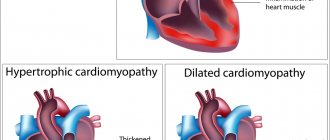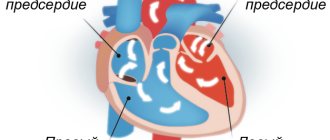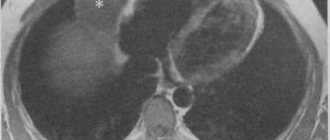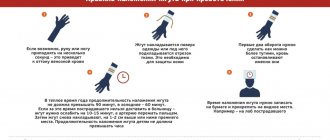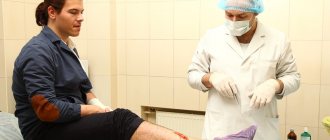Symptoms
Bleeding from the upper gastrointestinal tract is characterized by tarry stools, if the blood loss is extensive, then the stool may be tarry, the stool is black, semi-liquid, with an unpleasant odor.
There may be fresh blood in the stool if the blood loss is extensive. In this case, there is severe pain in the chest, bloody vomiting with clots the color of coffee grounds. This symptomatology is typical for bleeding from the stomach, duodenum, and esophagus. The appearance of blood from the anus is characteristic of bleeding from the colon or terminal ileum. When bleeding from the lower gastrointestinal tract, the stool is bloody, the discharge from the anus is bright red, the blood is mixed with the stool, and with extensive bleeding, symptoms of loss of circulating blood, hemorrhagic shock, and hypovolemia appear. When bleeding from anal fissures, scarlet blood is released during bowel movements.
When bleeding occurs, the patient experiences increased sweating, weakness, disorientation, pallor, tachycardia, and syncope.
With hidden bleeding from the upper gastrointestinal tract, there may be no vomiting mixed with black flakes, and the state of anemia increases.
What to do if there is blood in the stool
There can be only one correct decision in such a situation - to immediately visit a proctologist, who will conduct an examination, prescribe the necessary laboratory or instrumental tests, after which he will make an accurate diagnosis and prescribe the appropriate treatment. Statistics show that about 60-70% of rectal bleeding is caused by hemorrhoids, which can be successfully treated with modern medicine, and therefore one should not immediately suspect cancer and delay a visit to the doctor for fear of “hearing a bad diagnosis.”
Attention: any attempts to determine the cause of stool with blood on your own (so to speak, “by symptoms”), followed by self-medication, will only lead to aggravation of the disease and a worsening of the overall clinical prognosis, and therefore the medical doctor strongly does not recommend postponing a visit to the doctor if there is stool after bowel movements. Blood began to be observed, even in the smallest quantities.
Surgeon-coloproctologist, surgeon of the highest category. Rakhmatullin Andrey Albertovich
Diagnostics
Before diagnosing the source of bleeding, it is necessary to stabilize the patient's condition.
Intravenous administration of fluid or blood components is used, and respiratory resuscitation is additionally performed. Diagnostic methods:
- taking anamnesis;
- collection of clinical symptoms;
- laboratory diagnostics - general blood test, coagulogram, liver tests;
- digital examination of the rectum;
- instrumental diagnostics:
- endoscopic examination of the upper gastrointestinal tract if upper bleeding is suspected;
- angiography;
- irrigoscopy or CT enterography - for hidden bleeding;
colonoscopy – for bleeding from the lower sections;
Bleeding pattern and disease
- Regular heavy bleeding not associated with bowel movements - diverticulosis, polyposis, Crohn's disease, ulcerative colitis, rectal or colon cancer;
- Blood mixed with feces - cancer of the rectum and colon;
- Bleeding with diarrhea - dysbiosis, irritable bowel syndrome;
- Discharge of blood with mucus or pus - internal hemorrhoids, rectal prolapse or polyp;
- Severe bleeding with mucus - proctitis, colitis, rectal cancer.
Make an appointment
Crohn's disease
Crohn's disease is a severe inflammatory disease of all layers of the intestinal wall. In this case, nodules called granulomas appear inside the intestinal wall. The disease cannot be completely cured, only achieving remission. Crohn's disease affects all parts of the gastrointestinal tract. The mucous membrane becomes covered with ulcerative lesions, the ulcers can deepen, pseudopolyps are formed, polyps and ulcers alternate with each other. When the disease becomes more complicated, fever, bleeding, abscesses, fistulas, and peritonitis appear. Characterized by abdominal pain, flatulence, weight loss, anemia, hypovitaminosis. The disease develops slowly over several years. With Crohn's disease, symptoms such as damage to the joints, the mucous membrane of the eyes, and inflammation of the lymph nodes appear.
When self-medication is dangerous
A serious condition is indicated by constant scarlet discharge. The doctor will make an accurate diagnosis based on the results of laboratory and instrumental diagnostics.
Urgent hospitalization will be required if, along with this, the patient has:
- Nausea, vomiting with blood.
- Hematomas that occur without tissue injury.
- Weakness, confusion.
- Pain in the abdominal area.
- Fever.
In such cases, attempts to cope with the problem on your own are unacceptable. The desire to wait for a doctor’s consultation at the clinic also poses a threat to the patient’s life.
After relief of dangerous symptoms, an examination is prescribed to identify the cause of the condition. The further treatment regimen will be determined by a specialist of the appropriate profile.
Treatment
Treatment depends on the location of the bleeding and its intensity.
In case of minor bleeding, nutrition is adjusted, hemostatic drugs are prescribed, and deficiencies of microelements and vitamins are corrected. Additionally, the patient receives enteral or parenteral nutrition.
In case of acute bleeding, intensive therapy is necessary to stabilize the patient - restoration of circulating blood volume with the help of plasma substitutes or blood components. If respiratory function is impaired, it is necessary to restore respiratory function.
For varicose veins of the esophagus, endoscopic sclerotherapy, clipping, and vein ligation are used.
If this is ulcerative bleeding, endoscopic coagulation or angiographic embolization of the pathological vessel and intensive drug therapy with proton pump inhibitors are advisable.
For intestinal diverticulosis, the coagulation method is used, and hemostatic clips are used.
Preventing blood in stool
- 1. Annual preventive examinations with doctors.
- 2. Timely treatment of diseases.
- 3. Occult blood test.
- 4. Healthy lifestyle.
- 5. Eating foods containing fiber.
- 6. Daily physical activity.
How to prepare for the examination?
The own research of specialists from the proctology department of the Altermed clinic made it possible to make a visit to a proctologist as easy and comfortable as possible. There is no longer any need to fast the day before and plan the procedure for the morning. In the proctology departments of Altermed, a way has been found to successfully cope with all these difficulties. This is Microlax bowel preparation.
The use of Microlax microenemas makes fasting unnecessary, does not require special equipment or premises, and saves a lot of time. The laxative effect occurs 5-15 minutes after administration of the drug. The quality of bowel cleansing is such that treatment can begin immediately after rectoscopy and anoscopy. If it is necessary to use during pregnancy and lactation, Microlax does not require special precautions.
The Proctology Clinic provides diagnostics using the most modern equipment. The best doctors in St. Petersburg - both men and women - and a delicate approach are at your service.
Blood in the stool (medical: hematochezia, melena) is seen by most patients as something terrible. If you notice blood in your stool, you don’t have to worry about the worst, but you should immediately consult a doctor. Possible causes of blood in the stool include gastrointestinal infections, colon polyps or hemorrhoids, stomach ulcers or chronic inflammatory disease of the large intestine. To exclude the diagnosis of malignant diseases - such as intestinal cancer - it is necessary to immediately conduct appropriate research in the clinic. Below you will learn all the important information about the “blood in the stool” symptom.
Blood in the stool: Description
Blood in the stool indicates that the body is losing blood somewhere inside the gastrointestinal tract, which is then found mixed in the stool. The color and consistency of mixed blood can serve as an almost reliable indication of where the source of bleeding is located.
Blood in stool does not necessarily appear as a bright red or dark red coating or impurity; in fact, it can turn the stool black. The corresponding manifestations depend on the level of bleeding in the digestive tract, since the state of the blood changes upon contact with gastric juice and as a result of processing by microorganisms.
Red blood in the stool (hematochezia)
If the blood in the stool is bright red or dark red, in the form of impurities or streaks, then the blood is relatively fresh. This type of blood in the stool is called hematochezia. The source of bleeding is most likely in the middle or lower parts of the gastrointestinal tract (GIT), because the blood could not be destroyed in large quantities either by the hydrochloric acid of the stomach or by bacteria.
If the stool is uniformly dark red, this may indicate, for example, major bleeding in the large intestine. With minor bleeding, jelly-like traces of blood are observed in the stool.
In turn, light red stripes may indicate fresh bleeding in the rectal area, for example, with hemorrhoids.
Black blood in stool (melena, tarry stool)
If the stool is black and shiny, then we are talking about the so-called tarry stool (melena). When bleeding in the upper gastrointestinal tract, that is, from the esophagus to the duodenum, hemoglobin in the blood breaks down into hematin upon contact with gastric juice. This hematin is the cause of black stools, and in cases of vomiting, the vomit may resemble coffee grounds.
Black stool most often indicates that the source of the bleeding is higher than the small intestine and is caused by either a stomach ulcer or bleeding in the esophagus.
Since intestinal bacteria, with prolonged contact with blood, also cause the breakdown of hemoglobin into the pigment hematin, black stool may not necessarily be a consequence of bleeding in the upper gastrointestinal tract. When the passage of chyme (intestinal contents) is slow, melena can be caused by bleeding located deeper.
Under certain circumstances, high-lying bleeding in the gastrointestinal tract, on the contrary, can lead to hematochezia, both when the secretion of gastric juice decreases due to medication, and in case of severe bleeding, when chyme quickly passes through the intestines.
Hidden blood in stool
It may also be that although there is blood in the stool, it is not visible. Then we are talking about hidden blood. In most cases, it is discovered incidentally during a routine examination or during a targeted examination of known damage to the digestive tract.
Since blood cannot be detected with the naked eye, a guaiacol test for detecting blood in stool (hemoccult test) is used, which can detect even small quantities.
Cases that are confused with the presence of blood in the stool
After eating certain foods, your stool may look like there is blood in it. This is caused by the consumption of red beets, which stain the stool dark red, which occurs with hematochezia. Blueberries turn the stool black, similar to licorice, so that when examined, it is perceived as melena.
Also, some medications can cause black stool (for example, activated charcoal or iron supplements).
Blood in the stool: Causes and possible diseases:
Various possible reasons for the appearance of blood in the stool, causing bleeding in the gastrointestinal tract, are being considered. These include bleeding from the oropharynx, esophagus, stomach, small and large intestines and anus. In principle, bleeding can occur in every department, with the frequency and significance of different causes varying.
Blood in the stool due to bleeding in the upper digestive tract
- The most common cause of bleeding in the upper digestive tract is ulcers in the stomach and duodenum, often caused by Helicobacter pylori bacteria or long-term use of certain medications, such as aspirin.
- Chronic heartburn can, when gastric juice gets in, lead to inflammation of the esophagus (reflux esophagitis) and, as a result, bleeding.
- With certain liver diseases, a redistribution of venous blood flow occurs, which causes varicose veins of the esophagus. Such dilated veins easily rupture and lead to severe, often life-threatening bleeding.
- After profuse vomiting, extended tears of the mucous membrane may occur at the junction of the esophagus and the stomach. Then we are talking about Mallory-Weiss syndrome, often found in alcoholics who have previously had damaged mucous membranes.
- Finally, blood in the stool can also be a likely symptom of stomach cancer.
- In the middle sections of the digestive tract, the most common cause of bleeding is tumors of the small intestine. Also in the large intestine, atypical growths can lead to the appearance of blood in the stool. They do not have to be malignant.
- Particularly in young patients, chronic inflammatory bowel diseases such as Crohn's disease or ulcerative colitis can cause bleeding. If in the latter case only the colon and rectum are affected, then in Crohn's disease the entire gastrointestinal tract [can] be affected. The exact causes of both diseases are unknown.
- Polyps are most often benign growths of the large intestine that usually do not cause any problems, but as their size increases, the risk of bleeding also increases. They can also develop into pre-cancerous conditions, so after a certain size they are mostly removed. The consequence of such interventions, in turn, may be secondary bleeding.
- With diverticula, we are talking about protrusions of the walls of the intestinal wall, which, when viewed from the inside, are small “pits”. Diverticula most often form and are found in the large intestine. Depending on the circumstances, they can become inflamed (then we are talking about diverticulitis) and cause bleeding.
- Various intestinal infectious diseases, ranging from common gastroenteritis to severe diseases such as typhus or dysentery, can cause blood in the stool, most often in combination with diarrhea. Also, excessive proliferation of bacteria that make up the natural intestinal microflora, for example, after [a course of] antibiotic therapy, can cause hematochezia. An example is pseudomembranous colitis.
- Bright red blood in the stool often occurs with hemorrhoids. This usually refers to a pathological increase in arteriovenous anastomoses under the rectal mucosa. During defecation, they are often damaged, resulting in a coating of fresh, often bright red blood.
- Elderly people often experience so-called mesenteric infarctions, that is, blockage of intestinal vessels. If the tissues of the affected areas are damaged, subsequent bleeding may occur.
Blood in the stool due to bleeding in the middle and lower parts of the digestive tract
Blood in the stool: When should you see a doctor?
If you find blood in your stool, you should consult a doctor in any case. Despite the fact that most bleeding stops on its own without medical help and is often not dangerous. It is still necessary to find out where the source of the bleeding is and whether there is a more serious disease behind it. Especially if you have other symptoms, such as:
- Pain in the stomach and abdomen.
- Pain during bowel movements.
- Nausea and vomiting (including in the presence of blood in the vomit).
- Prolonged lethargy and fatigue.
- Pronounced weight loss in a short time.
- Night sweats.
You can't put off visiting a doctor.
If there is severe bleeding in the digestive tract after a certain period of time, anemia (anemia) may occur due to blood loss, which in any case requires treatment.
Blood in the stool: What does the doctor do?
If blood in the stool is caused by acute bleeding in the gastrointestinal tract, resulting in severe blood loss, it is necessary first of all to replace the missing blood volume. If left untreated, in worst cases it can lead to spinolaemic shock, a life-threatening condition.
The patient is placed in a supine position, receives oxygen through a nasal tube and, as soon as possible, a blood substitute to replenish lost blood volumes. In case of large blood losses, blood transfusions are also performed.
Also, with chronic bleeding in the gastrointestinal tract over a long period of time, anemia may develop, the treatment of which is similar [to the treatment of acute blood loss].
History and investigations
If a patient consults a doctor complaining of blood in the stool, in most cases the location of the bleeding is unknown and must be determined.
Medical history data can provide valuable guidance. For example, it may be important whether there has been blood in the stool before. It should also be clarified whether there were previously hemorrhoids, peptic ulcers, chronic inflammatory bowel diseases, alcohol abuse or diverticula, that is, whether there are risk factors for gastrointestinal bleeding. Next, studies are carried out to detect the source of bleeding.
- Of great importance in this case is gastroendoscopy, in which a gastric tube (gastroenteroscope) is inserted through the mouth and allows the doctor to assess the condition of the esophagus, stomach and duodenum using an endoscope. When examining the large intestine (coloscopy), the endoscope is inserted into the rectum and can be inserted down to the final part of the small intestine. Using these examination methods, many possible causes can be detected, such as diverticulum, chronic inflammation, ulcers, esophageal varices, colon polyps and other growths. Rectoscopy is most often used to examine hemorrhoids. Although the nature of the blood in the stool, as well as possible previously established diseases, can indicate the location of the source of bleeding, it is still better to use gastroduodenoscopy, especially in cases where the specific lesion cannot be identified.
Since gastroduodenoscopy cannot always determine the source of bleeding and, in addition, it is not always possible to obtain sufficient data, in such cases additional research methods are used.
- Double-balloon enteroscopy allows you to examine the condition of the small intestine. In this case, two balloons attached to the endoscope are alternately inflated so that they can be advanced along the length of the endoscope. This study is usually carried out in two stages - examination of the upper part of the small intestine with insertion of a probe through the mouth, and the lower part through the anus.
- Meanwhile, it is also possible to perform video capsule endoscopy. In this case, the patient swallows a mini-camera, which takes pictures at certain intervals. This way the small intestine is examined. However, this method takes time and does not allow precise localization of the source of bleeding.
- Ultrasound can help identify blockages in blood vessels as a possible cause of blood in the stool.
- Further, nuclear medicine techniques and selective arteriography can be used, which can detect only active bleeding.
- If it is suspected that the cause of blood in the stool is an infection, an attempt is made to identify the corresponding pathogen using stool and blood cultures.
Therapeutic measures
Treatment depends on the cause of the bleeding. First of all, you should, of course, stop active bleeding, then you need to prevent recurrent bleeding by fighting the cause.
In order to stop active bleeding in the digestive tract, various endoscopic techniques are first used. It is advisable that if the source of bleeding is detected during gastro- or colonoscopy, the cause of the bleeding can also be eliminated using one of the following methods:
- bleeding can be stopped, for example, with a hemoclip - a type of clamp that compresses the affected area.
- There are also injection techniques, in which a solution of adrenaline is injected into the site of bleeding with a needle, which compresses the blood vessels, or so-called fibrin glue can be injected.
- It is possible to use a laser to cauterize the bleeding site.
- The source of bleeding can be cut out microsurgically.
- In the case of esophageal varices and hemorrhoids, latex ligation is often used.
When the bleeding has stopped, treatment begins to eliminate the cause of the disease:
- For peptic ulcers, an attempt is made to reduce the production of stomach acid with the help of certain medications (proton pump inhibitors, PPIs), and dietary therapy can also be carried out. In case of Helicobacter pylori , a combination of various antibiotics is used.
- The cause of varicose nodes in the esophagus is high pressure in the portal vein system, and therefore they try to reduce it with the help of medications (beta blockers, spironolactone).
- Chronic inflammatory bowel diseases require special treatment, using anti-inflammatory drugs - glucocorticoids.
- Diverticulitis is treated with antibiotics. If this is no longer possible, the affected area of the intestine is removed.
- Intestinal polyps are also usually removed.
- For malignant diseases, surgery, chemotherapy and radiation therapy are considered.
How to contact us
Email: Tel.: +49 212 5476913 Viber | WhatsApp: +49 173-2034066 | +49 177-5404270 For your convenience, please save the phone number in your phone book and call or write to us for free on WhatsApp, Viber or Telegram. Applications made on weekends or holidays will be processed on the first business day.

